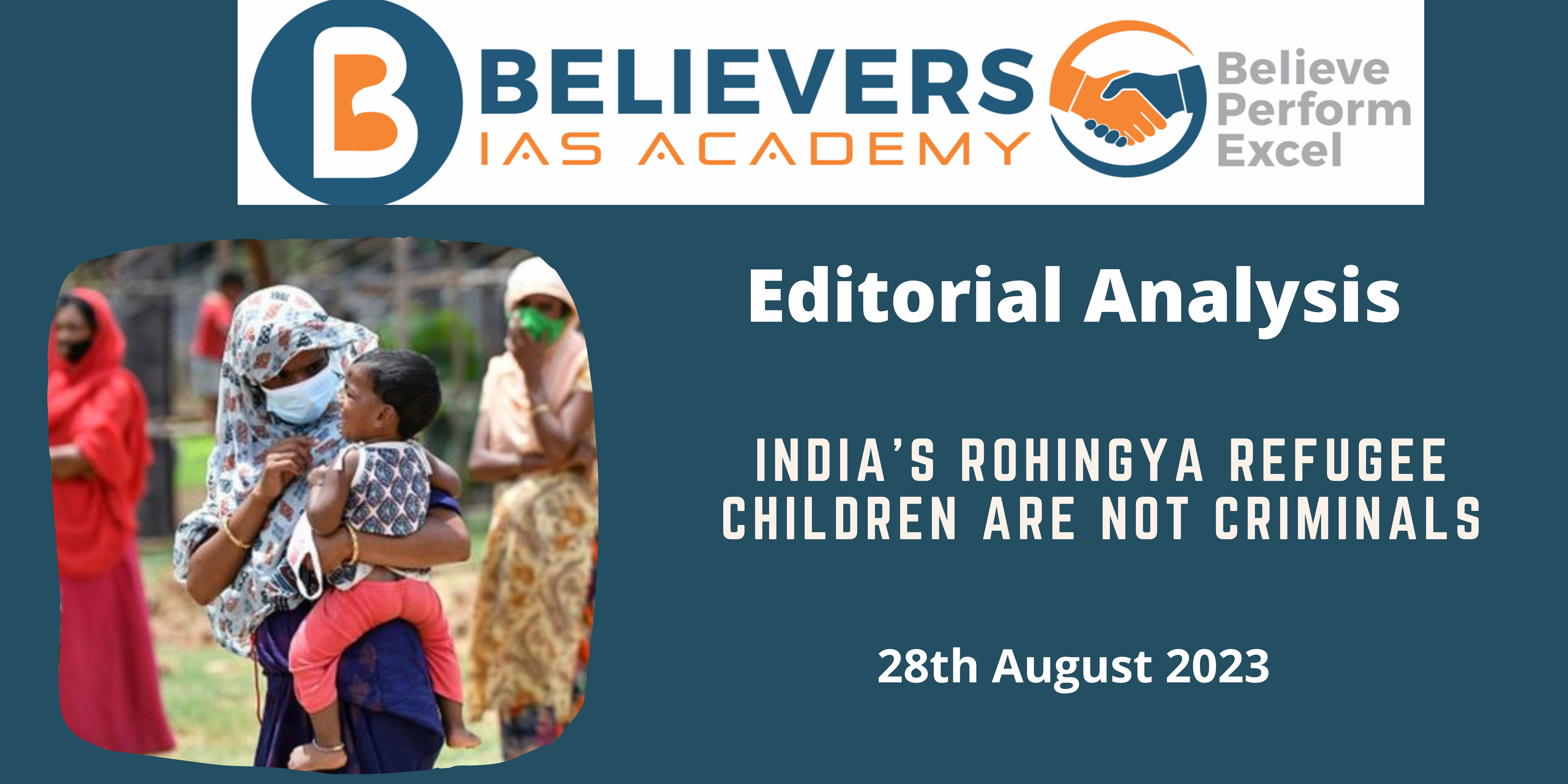India’s Rohingya refugee children are not criminals
Context:
The heart-wrenching demise of a five-month-old infant born to a Rohingya refugee in a Jammu detention center in July has ignited deep concerns. A viral video, now echoing across digital realms, captures the disturbing sight of police dispersing tear gas in a cramped corner of the center, where women and children huddle together.
Relevance:
GS – 03 (India and its Neighborhood)
GS – 02 (Effect of Policies & Politics of Countries on India’s Interests)
Prelims:
- Rohingya
- Myanmar
- United Nations High Commissioner for Refugees (UNHCR)
- Citizenship Amendment Act, 2019 (CAA)
- 1951 Refugee Convention.
Mains Question:
- Examine the challenges and implications of India’s approach towards refugees, particularly in light of the Rohingya crisis. Analyze the absence of a comprehensive legal framework for refugees, the consequences of treating them as illegal immigrants, and the impact of such policies on vulnerable populations. 150 words.
Dimensions of the Article:
- The Suffering Six Years Since Their Exodus
- Unanswered Questions
- Detention Under Foreigners Act
- Plight of Registered Refugees
- Trampled Rights of Rohingya Children
- Detained Rohingyas
- Misplaced Custody Under Juvenile Justice Act
- Path Toward Change
The Suffering Six Years Since Their Exodus:
- The calendar marked August 25, commemorating six years since the onset of a brutal campaign by the Myanmar military against the Rohingya minority in Rakhine State.
- This dark chapter commenced in August 2017 and resulted in the flight of over 770,000 Rohingya individuals.
- Over 20,000 of them sought refuge within India. One such haven, now a detention center, houses over 250 Rohingya refugees, including women and children, since March 2021. The majority of them wield UNHCR-issued cards validating their status as ‘seekers of refuge.’
Unanswered Questions:
- The incident in Jammu has unfurled inquiries. Why are these refugees, who flee persecution, shackled by the image of criminals? What forces them to dwell within prison-like confines? Why impose restraints on their movements? Above all, the confinement of children in detention centers casts a disquieting shadow.
- These young souls hail from an exceptionally vulnerable cohort, enveloped in the constant dread of ethnic purges. A global responsibility calls upon us to safeguard and nurture them, not to imprison, suffocate, or subject them to tear gas and neglect.
Detention Under Foreigners Act:
- The unsettling power wielded by Indian authorities is partly rooted in the nation’s lack of a consistent policy on refugees and asylum seekers. Bereft of adherence to the 1951 Refugee Convention and its 1967 Protocol, India treats refugees as clandestine migrants, grouping them under the Foreigners Act of 1946.
- This legislation furnishes unchecked executive prerogatives against foreign entities, devoid of any provisions for the safeguarding of vulnerable communities such as asylum seekers and refugees.
Plight of Registered Refugees:
- Even with UNHCR’s endorsement, registered refugees in India remain ensnared in the clutches of the Foreigners Act. The Act holds provisions for their arbitrary detention, and in some instances, propels them towards criminal imprisonment and deportation.
- Consequently, scores of Rohingya refugees, including numerous children, languish within India’s detention centers and prisons. For these innocents, the external world becomes a mere abstraction, confined within four austere walls.
Trampled Rights of Rohingya Children:
- Article 6 of the UN Convention on the Rights of the Child underscores every child’s innate entitlement to life, survival, and growth. India ratified this convention in December 1992, positioning the detention of children in facilities, their exclusion from education, and the curtailment of their liberties as outright violations.
- Closer to home, the Indian Constitution secures the right to life and personal liberty for all individuals, irrespective of citizenship or origin.
Detained Rohingyas:
- Nearly 500 Rohingya refugees, an alarming portion of them being children, endure detention across assorted facilities within India.
- Within the confines of New Delhi’s Sarai Rohilla center, a handful of children below the tender age of five gaze upon a gritty alley through iron bars.
- Their existence is cloaked in confinement, their identity as Rohingya refugees sealing their fate.
Misplaced Custody Under Juvenile Justice Act:
- Although some children share detention with their parents, others face separation, banished to juvenile justice institutions under the Juvenile Justice Act.
- These Rohingya children do not tread on the path of criminality; rather, they seek shelter after fleeing for their very lives.
- To label them as anything other than desperate souls seeking solace is a stark miscarriage of justice.
Path Toward Change:
- To prevent the tragic fate of another Rohingya child within Indian detention centers and to honor the essence of life and development, a compelling imperative surfaces: the immediate release of all Rohingya children and their primary caregivers from confinement. Beyond this, adherence to the 2011 internal guidelines of the Government of India pertaining to refugees must be observed.
- These guidelines advocate release from detention within six months, encompassing biometric details, contingent upon local surety, good conduct, and monthly police reporting.
- In parallel, the collaborative effort of the National Human Rights Commission of India and the Office of the United Nations High Commissioner for Human Rights should appoint an ombudsman with the exclusive mandate to investigate India’s refugee detention centers.
Way Forward:
The preservation of humanity’s noble ideals hinges upon the treatment of the most vulnerable among us. The path ahead entails a convergence of policy, compassion, and conscientious action, steering us away from darkness and toward the world where every soul, irrespective of origin, is embraced and uplifted.
Conclusion:
The demoralizing death of an infant within the Jammu detention center exemplifies the grievous consequences of treating refugees with disdain, denying them the sanctity of life and dignity. A shift is imperative, refugees deserve not imprisonment and indifference but sanctuary and compassion.




